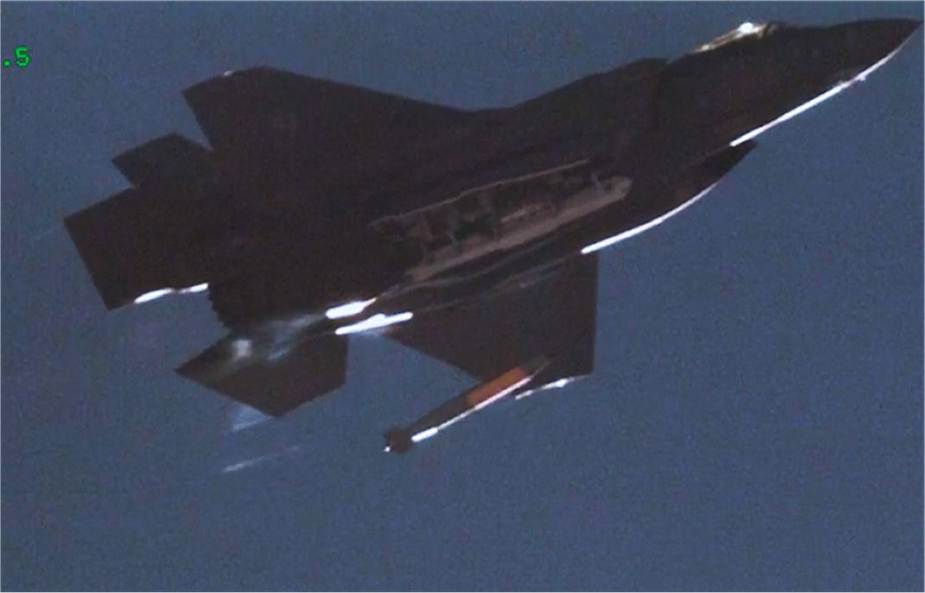According to a statement published on November 23, 2020, A mockup B61-12’s strike in the dusty Nevada desert successfully completed the first in a series of flight tests with the U.S. Air Force’s newest fighter jet F-35, demonstrating the B61-12 nuclear bomb’s mockup first release from an internal bomb bay at greater than the speed of sound.
Follow Air Recognition on Google News at this link
 An F-35A Lightning II opens its bomb bay doors and drops a mockup B61-12 nuclear bomb at Sandia National Laboratories’ Tonopah Test Range. (Picture source Sandia National Laboratories)
An F-35A Lightning II opens its bomb bay doors and drops a mockup B61-12 nuclear bomb at Sandia National Laboratories’ Tonopah Test Range. (Picture source Sandia National Laboratories)
The flight test of the B61-12 with the F-35A Lightning II this summer was the first ever at Sandia National Laboratories’ Tonopah Test Range featuring the fighter jet. It was also the first of a testing series that will conclude with full-weapon systems demonstrations designed to increase confidence the bomb will always work when needed and never under any other circumstances.
In partnership with the National Nuclear Security Administration, Los Alamos National Laboratory and the Air Force, Sandia completed a B61-12 full-weapon system demonstration with the F-15E Strike Eagle fighter jet in March, and another in July with the Air Force’s B-2 Spirit bomber.
Sandia is the design and engineering lab for non-nuclear components of the nation’s nuclear stockpile, including the B61-12. In addition to non-nuclear component development, Sandia serves as the technical integrator for the complete weapon, assuring the system meets requirements as a full-weapon system.
During the Aug. 25 flight test, an F-35A flying faster than the speed of sound dropped a B61-12 — containing non-nuclear and mock nuclear components — from about 10,500 feet above Tonopah Test Range. The inert B61-12 struck the desert floor in the designated target area about 42 seconds later.
Coordination between Sandia, Los Alamos, the NNSA and the Air Force made the flight test possible, and initial data shows that all systems and interfaces between the refurbished bomb and the F-35A worked as expected.
Unlike previous fighter jets, the F-35A carries the bomb internally. The recent flight test was the first demonstration of a fully instrumented B61-12 release from an internal bomb bay on a fighter and the first such release at speeds of Mach 1 or greater. The National Nuclear Security Administration recently announced plans to manufacture the first refurbished B61-12 in the fiscal year 2022.
The F-35A is a fifth-generation fighter and is described by an Air Force online fact sheet as an “agile, versatile, high-performance, 9-G capable multirole fighter” with stealth technology and advanced sensors. Nine countries — the United States, the United Kingdom, Italy, Netherlands, Turkey, Canada, Denmark, Norway and Australia — were involved in the fighter jet’s development.
The first B61 nuclear bomb entered service 50 years ago, and over the decade's numerous modifications have been made to increase safety and reliability. The B61 nuclear bomb is the primary thermonuclear gravity bomb in the United States Enduring Stockpile following the end of the Cold War. It is a low to intermediate-yield strategic and tactical nuclear weapon featuring a two-stage radiation implosion design.
The B61 Mod 12 upgrade is being pursued as a forward-deployed tactical/strategic nuclear weapon to protect NATO and Asian allies since it can be used from dual-capable fighter aircraft, as well as planned to arm the F-35 and B-21 Raider, and its lower yield options make it more flexible with fewer collateral effects.
The B61-12 air-launched tactical bomb carries a low-yield nuclear warhead to destroy military targets with minimum collateral damage. Located in the bomb’s middle section, the warhead will have four yield options, including 0.3kt, 1.5kt, 10kt, and 50kt. The bomb uses an inertial navigation system (INS) to achieve high kill probability while improving the survivability of the launch platform.
















